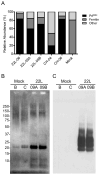Comparative profiling of highly enriched 22L and Chandler mouse scrapie prion protein preparations
- PMID: 20518029
- PMCID: PMC3742083
- DOI: 10.1002/pmic.201000104
Comparative profiling of highly enriched 22L and Chandler mouse scrapie prion protein preparations
Abstract
Transmissible spongiform encephalopathies (TSEs) or prion diseases are characterized by the accumulation of an aggregated isoform of the prion protein (PrP). This pathological isoform, termed PrP(Sc), appears to be the primary component of the TSE infectious agent or prion. However, it is not clear to what extent other protein cofactors may be involved in TSE pathogenesis or whether there are PrP(Sc)-associated proteins which help to determine TSE strain-specific disease phenotypes. We enriched PrP(Sc) from the brains of mice infected with either 22L or Chandler TSE strains and examined the protein content of these samples using nanospray LC-MS/MS. These samples were compared with "mock" PrP(Sc) preparations from uninfected brains. PrP was the major component of the infected samples and ferritin was the most abundant impurity. Mock enrichments contained no detectable PrP but did contain a significant amount of ferritin. Of the total proteins identified, 32% were found in both mock and infected samples. The similarities between PrP(Sc) samples from 22L and Chandler TSE strains suggest that the non-PrP(Sc) protein components found in standard enrichment protocols are not strain specific.
Conflict of interest statement
Figures




Similar articles
-
Prion seeding activities of mouse scrapie strains with divergent PrPSc protease sensitivities and amyloid plaque content using RT-QuIC and eQuIC.PLoS One. 2012;7(11):e48969. doi: 10.1371/journal.pone.0048969. Epub 2012 Nov 5. PLoS One. 2012. PMID: 23139828 Free PMC article.
-
Prion Protein Devoid of the Octapeptide Repeat Region Delays Bovine Spongiform Encephalopathy Pathogenesis in Mice.J Virol. 2017 Dec 14;92(1):e01368-17. doi: 10.1128/JVI.01368-17. Print 2018 Jan 1. J Virol. 2017. PMID: 29046443 Free PMC article.
-
Differences in proteinase K resistance and neuronal deposition of abnormal prion proteins characterize bovine spongiform encephalopathy (BSE) and scrapie strains.Mol Med. 1999 Jun;5(6):406-18. Mol Med. 1999. PMID: 10415165 Free PMC article.
-
Insights into Mechanisms of Transmission and Pathogenesis from Transgenic Mouse Models of Prion Diseases.Methods Mol Biol. 2017;1658:219-252. doi: 10.1007/978-1-4939-7244-9_16. Methods Mol Biol. 2017. PMID: 28861793 Free PMC article. Review.
-
Insights into prion strains and neurotoxicity.Nat Rev Mol Cell Biol. 2007 Jul;8(7):552-61. doi: 10.1038/nrm2204. Nat Rev Mol Cell Biol. 2007. PMID: 17585315 Review.
Cited by
-
Role of cyclophilin A from brains of prion-infected mice in stimulation of cytokine release by microglia and astroglia in vitro.J Biol Chem. 2012 Feb 10;287(7):4628-39. doi: 10.1074/jbc.M111.269480. Epub 2011 Dec 16. J Biol Chem. 2012. PMID: 22179611 Free PMC article.
-
A specific population of abnormal prion protein aggregates is preferentially taken up by cells and disaggregated in a strain-dependent manner.J Virol. 2013 Nov;87(21):11552-61. doi: 10.1128/JVI.01484-13. Epub 2013 Aug 21. J Virol. 2013. PMID: 23966386 Free PMC article.
-
Identification and removal of proteins that co-purify with infectious prion protein improves the analysis of its secondary structure.Proteomics. 2011 Oct;11(19):3853-65. doi: 10.1002/pmic.201100253. Epub 2011 Sep 7. Proteomics. 2011. PMID: 21805638 Free PMC article.
-
The Distribution of Prion Protein Allotypes Differs Between Sporadic and Iatrogenic Creutzfeldt-Jakob Disease Patients.PLoS Pathog. 2016 Feb 3;12(2):e1005416. doi: 10.1371/journal.ppat.1005416. eCollection 2016 Feb. PLoS Pathog. 2016. PMID: 26840342 Free PMC article.
-
Na+/K+-ATPase is present in scrapie-associated fibrils, modulates PrP misfolding in vitro and links PrP function and dysfunction.PLoS One. 2011;6(11):e26813. doi: 10.1371/journal.pone.0026813. Epub 2011 Nov 2. PLoS One. 2011. PMID: 22073199 Free PMC article.
References
-
- Chesebro B. Introduction to the transmissible spongiform encephalopathies or prion diseases. Br Med Bull. 2003;66:1–20. - PubMed
-
- Caughey BW, Dong A, Bhat KS, Ernst D, et al. Secondary structure analysis of the scrapie-associated protein PrP 27–30 in water by infrared spectroscopy. Biochemistry. 1991;30:7672–7680. - PubMed
-
- Chiti F, Dobson CM. Protein misfolding, functional amyloid, and human disease. Annu Rev Biochem. 2006;75:333–366. - PubMed
Publication types
MeSH terms
Substances
Grants and funding
LinkOut - more resources
Full Text Sources
Research Materials

